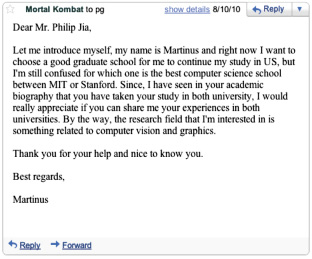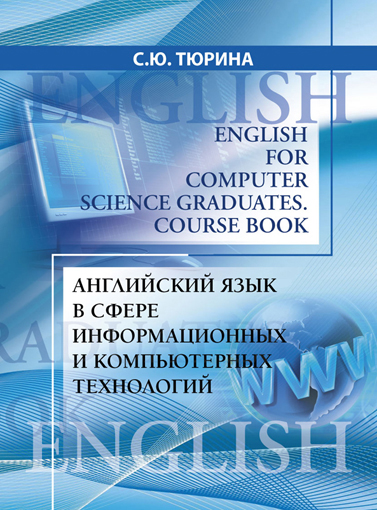
Научная электронная библиотека
Монографии, изданные в издательстве Российской Академии Естествознания
Appendix 3.
WRITING TIPS
http://www.stanford.edu/~pgbovine/computer-science.htm
Write to the right person
Before you write an email, think about whether it is appropriate to contact this person at this time. Read his/her website to see if there is an FAQ that might answer your question, whether his/her assistant might be able to help you out, or whether he/she has an explicit «don’t email me» policy.
Make the subject line clear and concise
When someone scans through new email, the first and only thing he/she initially reads is the subject line, so make sure that it clearly summarizes your email’s intentions. Remember to keep it short. Also, don’t ever send an email with an empty subject line.
Use an appropriate greeting
The first line of your email should be a greeting, followed by an empty line and then your message body. Always strive to be as formal as possible, especially for first impressions. Use the most distinguished title for the recipient. For example, for a professor named John Smith, use «Prof. Smith» instead of «Dr. Smith». For someone with a medical or doctorate degree, use «Dr. Smith». Otherwise, use «Mr.», «Ms.», or whatever else is appropriate.
Beware of using first names unless you are already on a first-name basis with the recipient. If he/she replies to your initial message, chances are, he/she will sign the reply with his/her first name, like «Regards, John». Do not take this to mean that you now have permission to call him «John» in your next email. Still use «Prof. Smith» unless he explicitly says, «you can call me John». It never hurts to be a bit too formal at first.
Introduce yourself in one sentence
Introduce yourself briefly using only one sentence right after your greeting. Write only what is relevant to let this person know what he/she needs to know about you.
If you have interacted with this person before, remind him/her in this first sentence so that he/she can quickly retrieve a mental image of you (e.g., «I’m Joe, the student who talked to you about my 3-D game project at the career fair last week».).
The first (non-introductory) sentence is the most important.
After you have introduced yourself if necessary, the next sentence is the most important one in the entire email. This is like your thesis sentence – say what you want to say right now!
Busy people don’t want to read several paragraphs without knowing what you want from them.
Put all important details at the top of the email body (or even better, in the Subject line)
Don’t bury a key piece of information inside of a large paragraph and expect a busy person to quickly be able to extract it upon first reading. The larger the paragraph (and the more paragraphs there are), the more likely that the reader will miss a particular point you are trying to make while he/she is skimming your email.
Keep the rest of the email short
After you’ve made your main point, the rest of the sentences in your email should provide additional supporting information. Unless there is an obvious need to write a long email, keep the email as short as possible.
8 sentences should be more than enough for a general-purpose email. Don’t overwhelm your reader with details unless he/she explicitly asked for them. Separate paragraphs with a blank line to improve readability; it’s okay to have 1- or 2-sentence paragraphs when your entire email is around 8 sentences.
The final sentence – Either provide something concrete to reply to or make it clear that a reply is not necessary
Is the purpose of your email to elicit a reply? If so, make sure that your purpose is clear in the final sentence. You need to provide something concrete and unambiguous for the recipient to reply to. Throw the ball back into his/her court with something like «Please let me know what appointment times work best for you» or «I am free Tuesday 11-2 or Thursday 1-5; let me know which is best for you».
If you do not expect a reply and merely want to share some information with your recipient, then simply summarize the information in the final sentence.
Make your concluding phrase and signature context-appropriate
If you are expecting a reply, write a simple «Thanks.» after the final sentence. If the person is doing a favor, write something stronger, like «Thanks a lot.» or «Thanks in advance.» If you are not expecting a reply, you might end with «Take care.» or «Best wishes.»
Sign the letter with your first name, or in a more formal occasion, use your first and last names. You can include other contact information such as cell phone number if it is relevant.
If you must re-send a message, do so apologetically
If you’ve emailed someone and he/she hasn’t responded in a reasonable amount of time, then it might be appropriate to re-send your original message as a gentle reminder. Perhaps the recipient was simply too busy to respond to you when you first sent it, and then your email got buried beneath more recent incoming emails.
The worst thing to do is to pester an already-busy person by re-sending your email with a note like «Have you had time to address my email yet? If not, here it is again.
A more tactful reminder would be to somehow pin the blame on yourself. For instance, you could blame either your email software or your own computer illiteracy, like «My email server has been acting up lately, so I’m not sure whether my previous message was went properly; here it is again just in case. Thanks!»
Write in proper English, not like ur txt msging ur friendz, lolz!
Your bosses and professors aren’t your friends, so don’t message them like you would to your bff.
hi my name iz johnny, plz tell me how to get into a goot grad skool, i have a good gpa and gre scorez. lol. thx bye guy!
Don’t misspell your recipient’s name
Well, you shouldn’t misspell anything in your email. One brain-dead way to prevent this stupid mistake is to simply copy-and-paste the person’s name into your email, either from a previous email he/she has sent to you or from a personal web site.
Make sure you don’t have a silly username
In other words, don’t be like this poor guy:

